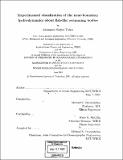| dc.contributor.advisor | Michael S. Triantafyllou and Wade R. McGillis. | en_US |
| dc.contributor.author | Techet, Alexandra Hughes | en_US |
| dc.contributor.other | Woods Hole Oceanographic Institution. | en_US |
| dc.date.accessioned | 2005-09-27T20:18:49Z | |
| dc.date.available | 2005-09-27T20:18:49Z | |
| dc.date.copyright | 2001 | en_US |
| dc.date.issued | 2001 | en_US |
| dc.identifier.uri | http://hdl.handle.net/1721.1/29051 | |
| dc.description | Thesis (Ph. D.)--Joint Program in Applied Ocean Physics and Engineering (Massachusetts Institute of Technology, Dept. of Ocean Engineering and the Woods Hole Oceanographic Institution), 2001. | en_US |
| dc.description | Includes bibliographical references (leaves 149-155). | en_US |
| dc.description.abstract | This thesis takes a look at the near boundary flow about fish-like swimming bodies. Experiments were performed up to Reynolds number 106 using laser Doppler velocimetry and particle imaging techniques. The turbulence in the boundary layer of a waving mat and swimming robotic fish were investigated. How the undulating motion of the boundary controls both the turbulence production and the boundary layer development is of great interest. Unsteady motions have been shown effective in controlling flow. Tokumaru and Dimotakis (1991) demonstrated the control of vortex shedding, and thus the drag on a bluff body, through rotary oscillation of the body at certain frequencies. Similar results of flow control have been seen in fish-like swimming motions. Taneda and Tomonari (1974) illustrated that, for phase speeds greater than free stream velocity, traveling wave motion of a boundary tends to retard separation and reduce near-wall turbulence. In order to perform experiments on a two-dimensional waving plate, an apparatus was designed to be used in the MIT Propeller tunnel, a recirculating water tunnel. It is an eight-link piston driven mechanism that is attached to a neoprene mat in order to create a traveling wave motion down the mat. A correlation between this problem and that of a swimming fish is addressed herein, using visualization results obtained from a study of the MIT RoboTuna. The study of the MIT RoboTuna and a two-dimensional representation of the backbone of the robotic swimming fish was performed to further asses the implications of such motion on drag reduction. PIV experiments with the MIT RoboTuna indicate a laminarisation of the near boundary flow for swimming cases compared with non-swimming cases along the robot body. Laser Doppler Velocimetry (LDV) and PIV experiments were performed. | en_US |
| dc.description.abstract | (cont.) LDV results show the reduction of turbulence intensity, near the waving boundary, for increasing phase speed up to 1.2 m/s after which the intensities begin to increase again through Cp = 2.0 where numerical simulations by Zhang (2000) showed separation reappearing on the back of the crests. Velocity profiles who an acceleration of the fluid beyond the inflow speed at the crest region increases with increased phase speed and no separation was present in the trough for the moving wall. The experimental techniques used are also discussed as they are applied in these experiments. | en_US |
| dc.description.statementofresponsibility | by Alexandra Hughes Techet. | en_US |
| dc.format.extent | 155 leaves | en_US |
| dc.format.extent | 12787005 bytes | |
| dc.format.extent | 12786764 bytes | |
| dc.format.mimetype | application/pdf | |
| dc.format.mimetype | application/pdf | |
| dc.language.iso | eng | en_US |
| dc.publisher | Massachusetts Institute of Technology | en_US |
| dc.rights | M.I.T. theses are protected by copyright. They may be viewed from this source for any purpose, but reproduction or distribution in any format is prohibited without written permission. See provided URL for inquiries about permission. | en_US |
| dc.rights.uri | http://dspace.mit.edu/handle/1721.1/7582 | |
| dc.subject | Ocean Engineering. | en_US |
| dc.subject | Joint Program in Applied Ocean Physics and Engineering. | en_US |
| dc.subject | Woods Hole Oceanographic Institution. | en_US |
| dc.subject.lcsh | Hydrodynamics | en_US |
| dc.subject.lcsh | Wave makers | en_US |
| dc.subject.lcsh | Fishes Locomotion | en_US |
| dc.title | Experimental visualization of the near-boundary hydrodynamics about fish-like swimming bodies | en_US |
| dc.type | Thesis | en_US |
| dc.description.degree | Ph.D. | en_US |
| dc.contributor.department | Joint Program in Applied Ocean Physics and Engineering | en_US |
| dc.contributor.department | Woods Hole Oceanographic Institution | en_US |
| dc.contributor.department | Massachusetts Institute of Technology. Department of Ocean Engineering | |
| dc.identifier.oclc | 50180655 | en_US |
